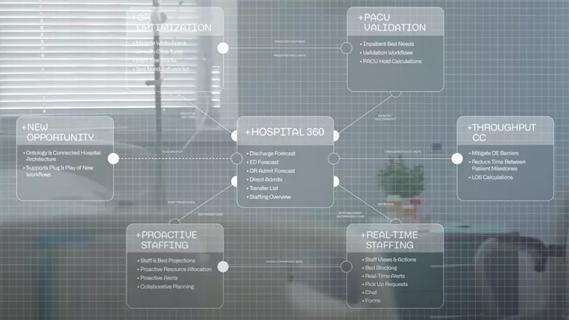Popular management strategy helps organization define success and track results

The 2023 Wimbledon championship, the oldest and arguably most prestigious tennis competition in the world, just witnessed an unexpected and thrilling run by Chris Eubanks, a relatively new member of the tennis elite. Having recently broken into the Top 100, Eubanks advanced to the quarterfinals in his first-ever Wimbledon appearance but was eventually defeated in five sets by the world’s No.3 player.
Advertisement
Cleveland Clinic is a non-profit academic medical center. Advertising on our site helps support our mission. We do not endorse non-Cleveland Clinic products or services. Policy
When so-called Cinderella stories like these make the news, they capture the heart and attention of the world. An underdog’s ability to surpass seemingly unachievable goals makes us take notice. The improbability of success can make such victories all the more inspiring.
But Chris Eubanks’ story isn’t magical. It’s not even a modern-day parable about hard work and perseverance. Probably unbeknownst to him, Eubanks’ phenomenal accomplishment reads like a masterclass in leaning into the structure and behaviors that have driven eye-popping results across many business sectors and industries. Described by John Doerr in the #1 New York Times Bestselling Book Measure What Matters, a system of objectives and key results (OKRs) has propelled countless organizations and individuals toward success.
The key principles of OKRs are seemingly simple:
Advertisement
For Chris Eubanks, who was ranked 150th when he went pro in 2017, one early objective was to break into the Top 100 of tennis pros. He has described his singular focus on achieving that goal and the meaningful purpose behind his efforts: Being in the Top 100 ensured financial security and better opportunities for the future. It was an ambitious but not unimaginable aim. He was working hard, staying focused and keeping his eye on the future – but he continued to fall short. As he described it, his rankings fluctuated from 150 to 230. Although he managed to climb to 102 at one point, he quickly dropped back to 120. Unable to get where he wanted to be, frustration built up.
But Eubanks soon came to a conclusion that made a pivotal difference in his success. He realized that while it was important to identify a desired outcome, Top 100 wasn’t going to happen in one match. He couldn’t achieve this outcome by merely placing his emphasis there. Instead, Eubanks realized something much more impactful. “I can just focus on the process and just have faith that if I do those things properly to get there, it will happen,” he said. The process was within his control. He said he controlled what he could, explaining, “…then you look up, and things have changed quickly.”
What Eubanks discovered is that knowing where you want to end is not enough – you must focus consistently on the steps to get there. Eubanks didn’t lose sight of his objective. Although achieving an elite ranking was his measure of ultimate success, he quickly shifted his focus from outcome to key results – the daily, weekly and monthly process metrics he could control and that, when taken together, enabled him to achieve his objective.
Advertisement
At Cleveland Clinic, we similarly use a system of OKRs to define and deliver on improbably audacious goals. “Be the best place to receive care anywhere.” “Be the best place to work in healthcare.” These ambitious objectives guide our priorities. However, in an organization of more than 70,000 caregivers, understanding these objectives and defining what constitutes success can be difficult and adds a layer of complexity with which Chris Eubanks didn’t have to contend. But OKRs create the infrastructure for leaders at every level to help them define exactly how they will contribute to that seemingly unimaginable goal.
OKRs create a common language that communicates ways to close the gap between where we are today and the ideal healthcare system we strive to become. Most importantly, OKRs allow us to measure and monitor our progress so we can be confident that we are getting ever closer to our goals.
Effectively executing using a system of OKRs makes the difference between incremental improvements and predictable acceleration. But simply applying an OKR structure as an exercise doesn’t compel change. Eubanks’ story highlights that the tool itself isn’t magic; both structure and behavior matter.
The structure – a combination of aspirational objectives and practical, measurable key results is an important start. But the associated behaviors – intimately understanding and communicating why the key results will drive improvement in the objective, closely monitoring progress, maintaining focus, prioritizing controllable factors, accomplishing and replacing key results successively – are essential to achieving results.
Advertisement
Interacting on a regular basis with the key results that chip away at the barriers to the outcome develops a resilience that transcends the challenges we inevitably face, threatening to derail all the hard work that has been done. Chris Eubanks will leave Wimbledon ranked near 31, far surpassing the original goal he set before shifting his focus to his process.
What makes Eubanks’ story particularly compelling is that he ultimately found success playing on unfamiliar turf. He won despite being unaccustomed to playing on a grass court, a surface that greatly affected the acceleration and deceleration of the ball, its bounce, spin, and height. Achieving success in this unlikely scenario highlights how OKRs empower practitioners. The rigorous structure provided by OKRs emphasizes that it is within one’s grasp to move the needle on what matters most, regardless of conditions.
Healthcare often requires quick reactions and fast decisions that don’t generally align well with setting and achieving long-term goals. Evolving care delivery models, challenging reimbursement structures and global pandemics cause our proverbial tennis balls to take unpredictable bounces. But using OKRs effectively to define and execute our goals can make the seemingly impossible possible.
Just as Chris Eubanks discovered, merely aiming to be the best won’t make it so. But by focusing doggedly on the things we can control, following the process steps, measuring our progress and compelling the metrics to move, healthcare can and will achieve the unachievable.
Advertisement
Advertisement

Digital “tripwires” detect and respond to malicious activity, boosting cybersecurity maturity

Thoughtful collaboration, data-driven decisions and effective change management lead to significant savings

Clinical input is integral to technology implementation and adoption strategy

Unit-based project decreases non-urgent alarms

Integrating technology is more than product delivery

Cleveland Clinic partners with Palantir to create logistical command center

Cleveland Clinic’s roadmap to recovering critical digital assets stems from strategic planning and preparedness

The Friends of Cybersecurity program bridges innovative technology solutions with mitigating security risks